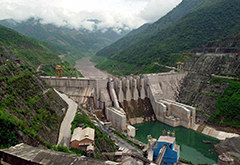The estimated hydropower potential of the lower Mekong Basin (i.e., excluding China) is 30,000 MW, while that of the upper Mekong Basin is 28,930 MW. In the lower Mekong, more than 3,235 MW has been realized via facilities built largely over the past ten years, while projects under construction will represent an additional 3,209 MW. An additional 134 projects are planned for the lower Mekong, which will maximize the river's hydropower generating capacity. The single most significant impact—both now and in the future—on the use of water and its management in the Mekong Region is hydropower.
 Given current development trends in the region, power demands are expected to rise seven percent per year between 2010 and 2030, yielding a substantial and potentially lucrative energy market. Hydropower is the favoured energy option for the Mekong's riparian countries.
Given current development trends in the region, power demands are expected to rise seven percent per year between 2010 and 2030, yielding a substantial and potentially lucrative energy market. Hydropower is the favoured energy option for the Mekong's riparian countries.
The development of the Mekong River Basin is highly controversial, and is one of the most prominent components in the discussion about the river and its management. This debate occurs in both the academic literature, as well as the media, and is a focus for many activist groups.
A study by the Mekong River Commission (MRC) presented at the Third MRC International Conference in March 2018, concluded that hydropower development on the Mekong River will aggravate food insecurity and poverty in the region. The report forecasts that Thailand is expected to suffer the most economically and ecologically. According to the report, full scale dam development will decrease GDP growth for lower Mekong basin countries by US$29 billion. Thailand would have the greatest economic loss, as much as US$11 billion. Laos and Cambodia would each face losses of US$9 billion in GDP growth. Native fish stocks would be particularly hard hit: more than 900,000 tonnes of fish biomass, worth US$4.3 billion, would disappear by 2040 from the Mekong as a result of dams.
Thailand would have the highest rate of fish loss, 55 percent, followed by Laos, 50 percent; Cambodia, 35 percent; and Vietnam, 30 percent. The creation of reservoirs would result in many parts of the Mekong becoming a lake ecosystem, unsuitable for many native aquatic species of the river environment and will eventually drive them to extinction. A Lao government executive dismissed the research findings as "just an estimation". He insisted that hydropower dams were crucial to solving poverty and that they would provide large economic benefits to the entire region. More details
 Given current development trends in the region, power demands are expected to rise seven percent per year between 2010 and 2030, yielding a substantial and potentially lucrative energy market. Hydropower is the favoured energy option for the Mekong's riparian countries.
Given current development trends in the region, power demands are expected to rise seven percent per year between 2010 and 2030, yielding a substantial and potentially lucrative energy market. Hydropower is the favoured energy option for the Mekong's riparian countries.The development of the Mekong River Basin is highly controversial, and is one of the most prominent components in the discussion about the river and its management. This debate occurs in both the academic literature, as well as the media, and is a focus for many activist groups.
A study by the Mekong River Commission (MRC) presented at the Third MRC International Conference in March 2018, concluded that hydropower development on the Mekong River will aggravate food insecurity and poverty in the region. The report forecasts that Thailand is expected to suffer the most economically and ecologically. According to the report, full scale dam development will decrease GDP growth for lower Mekong basin countries by US$29 billion. Thailand would have the greatest economic loss, as much as US$11 billion. Laos and Cambodia would each face losses of US$9 billion in GDP growth. Native fish stocks would be particularly hard hit: more than 900,000 tonnes of fish biomass, worth US$4.3 billion, would disappear by 2040 from the Mekong as a result of dams.
Thailand would have the highest rate of fish loss, 55 percent, followed by Laos, 50 percent; Cambodia, 35 percent; and Vietnam, 30 percent. The creation of reservoirs would result in many parts of the Mekong becoming a lake ecosystem, unsuitable for many native aquatic species of the river environment and will eventually drive them to extinction. A Lao government executive dismissed the research findings as "just an estimation". He insisted that hydropower dams were crucial to solving poverty and that they would provide large economic benefits to the entire region. More details